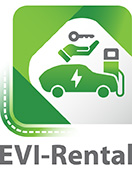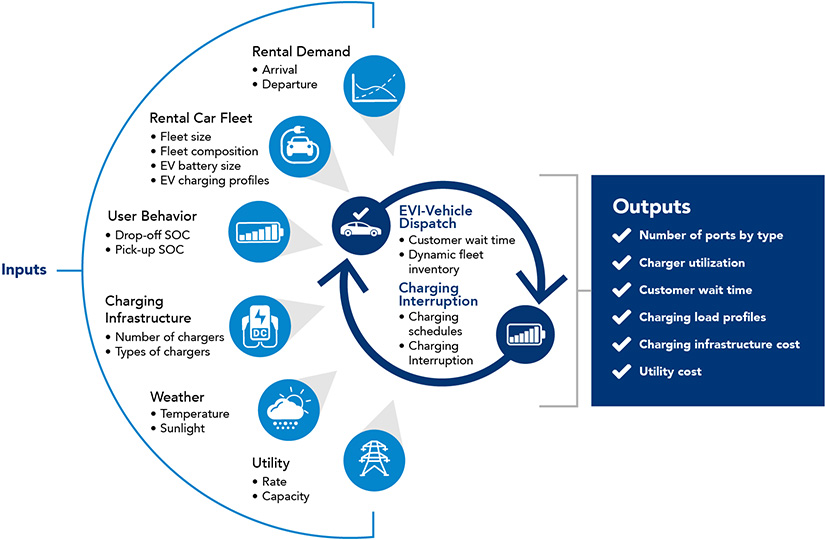EVI-Rental: Electric Vehicle Infrastructure – Rental Car Tool

NREL's Electric Vehicle Infrastructure – Rental Car (EVI-Rental) tool simulates various aspects of rental car operations, including electric vehicle (EV) charging, vehicle dispatch, customer experience, and fleet turnover.
EVI-Rental can:
- Estimate charging demand
- Assist with charging infrastructure design
- Quantify how rental car electrification affects grid loads, customer wait times, and life-cycle costs.
EVI-Rental will be available via the Athena Aeroportal in early 2026.
Approach and Capabilities
EVI-Rental simulates electrified rental car operations and can be leveraged to estimate charging demand, select the appropriate charging infrastructure design, and quantify grid load impact of any given rental car fleet to minimize costs and maximize operational efficiency and reliability.
The tool enables the evaluation of rental car electrification under different policy and operational assumptions, such as different vehicle state of charge requirements upon pickup and return, rental car fleet inventory and compositions, types and quantities of EV chargers, and charging schedules.
EVI-Rental is a discrete-event simulation tool composed of several key modules: a vehicle dispatcher that assigns vehicles to customer requests based on request type and availability; a charging scheduler that determines when vehicles are plugged in or unplugged and selects the appropriate charger; and a charging process module that models how the charging rate dynamically varies with the battery's state of charge.
By tracking the status of the customers, fleet, and charging infrastructure, the tool also measures the impact of electrification on customer wait times and rental car life cycle costs.

EVI-Rental simulates various aspects of electrified rental car operations. Image by Taylor Henry, NREL
Evaluation Options
Load profile and infrastructure design outputs generated by EVI-Rental can be fed into NREL's EDGES: Enabling Distributed Generation Energy Storage model to evaluate behind-the-meter storage and distributed photovoltaic generation systems as potential solutions for meeting increased electricity demand from electrification.
The NREL-led Athena project, which is supported by the U.S. Department of Energy, helps airports make informed energy infrastructure and equipment decisions. Researchers develop models and provide access to EVI-Rental and other tools that account for the complexity and critical nature of airport operations to develop customized recommendations.
Publications
EVI-Rental: A Scalable Model To Quantify the Impact of Rental Car Electrification, NREL Fact Sheet (2025)
Contact
To learn more about EVI-Rental, contact [email protected].
Share
Last Updated Nov. 17, 2025
